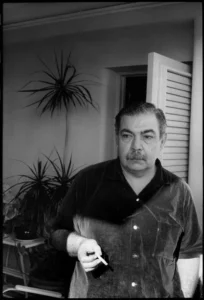Rene Portocarrero

Portocarrero, Rene, Cerro, Cuba (February 24, 1912 – April 7, 1985) From a very young age he showed his vocation for painting. Although he attended classes at the San Alejandro Academy of Plastic Arts, his training was mainly self-taught. He held his first exhibition, at the Lyceum of Havana, in 1934. Later he worked at the Estudio Libre para Painters and Sculptors of Havana, together with Mariano Rodríguez. Linked to the generation of poets of the so-called “Orígenes group”, he published drawings in several literary magazines, such as Verbum, Espuela de Plata and Orígenes. During this time he published two books: The Masks (1935) and The Dream (1939), the second of which also included texts by the painter.
In 1944 he exhibited his works in New York, at the Julian Levy Gallery and at the Museum of Modern Art. He later became interested in popular Cuban festivals, a topic to which he dedicated a series of pastel paintings. Around 1950 he began working on decorating ceramic pieces at the Taller Experimental de Santiago de Las Vegas. Using this technique he created a large mural, titled History of the Antilles, for the Habana Hilton hotel (today Habana Libre).
In 1951 he received the National Painting Prize for his painting Homage to Trinidad, currently in the Museum of Fine Arts of Cuba, which marks the beginning of a series of landscapes inspired by the Cuban capital, the so-called “Landscapes of Havana.” In 1962, he inaugurated the exhibition “Color of Cuba”, on Afro-Cuban Santeria motifs. The Cuban carnival was the subject of another of his series of paintings, “Carnavales” (1970-1971). He participated in the São Paulo Biennale in 1957 and 1963, and in Venice in 1952 and 1966.
He is currently considered one of the most outstanding figures of Cuban plastic arts and one of the main artists of the 20th century in Cuba. His pictorial themes are often related to the Afro-Cuban tradition, approached from a poetic perspective.1 His style, characterized by vibrant color, has been considered to have baroque roots. He held more than 20 personal and 60 group exhibitions.
Distinctions and decorations
• Polish Order of Culture, the highest decoration awarded by this country to the most outstanding foreign intellectuals.
• Cyril and Methodius Order of the Second Degree of Bulgaria in 1976.
• In 1979 he was named Honorary Advisory Member of the International Association of Fine Artists of UNESCO.
• On October 4, 1981 he was awarded the Félix Varela Order of the First Degree, awarded by the Council of State of the Republic of Cuba.
• On September 14, 1982, the Aztec Eagle, the highest Mexican decoration, was awarded to him.
Exhibitions
1934: He held his first personal exhibition at the Lyceum society in Havana.
1935: Participates in the National Exhibition of Painting and Sculpture, the first official exhibition convened by a state agency, in which avant-garde painters such as Víctor Manuel, Amelia Peláez, Carlos Enriquez and Fidelio Ponce also participate.
1936: He exhibits a collection of drawings at the Lyceum Society, to which he preferentially dedicated himself during these years.
1937: He exhibits another collection, this time of 13 drawings, at the Modern Art Exhibition, a summary of ten years of work by Cuban avant-garde artists.
1938: Sends two works to the II National Exhibition of Painting and Sculpture.
1940: Creates vignettes for the catalogs of two important exhibitions of Cuban art at the University of Havana: Art in Cuba and 300 years of Art in Cuba.
1944: He holds his great personal exhibition, with 140 works, in the Science Hall of the University of Havana.
1951: Participates in the I Sao Paulo Biennial.
1960: The first retrospective exhibition of Portocarrero (1933-1960) is organized at the José Martí National Library.
1963: The Color of Cuba exhibition takes place.
1965: Attends his personal exhibition at the Museum of Modern Art in Mexico City.
1966: He exhibits the series of 27 oil paintings Portraits of Flora, in a personal room, invited by the authorities of the XXXIII Venice Biennale.
1967: The large retrospective exhibition, with more than 300 works, is organized at the National Museum of Fine Arts in Havana.
1979: He exhibits the Carnivals for the first time at the National Museum of Fine Arts in Havana, as well as in Poland.
1980: Exhibits at the Museum of Modern Art of Mexico.
1982: The Capital Works of René Portocarrero exhibition opens at the National Museum of
Fine Arts and exhibits his series Transfiguration and Fugue at the Amelia Peláez Gallery in Lenin Park.
1982 – 1984: A traveling exhibition of one hundred works by Portocarrero is held in several European countries.
1983: Works from the Transfigurations and Eternal Mothers series are exhibited at the National Museum of Fine Arts.